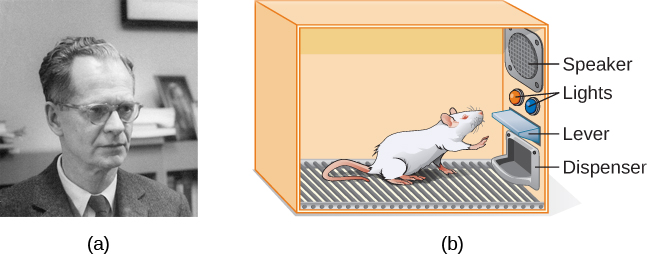| << Chapter < Page | Chapter >> Page > |

Watch this brief video clip to learn more about operant conditioning: Skinner is interviewed, and operant conditioning of pigeons is demonstrated.
In discussing operant conditioning, we use several everyday words—positive, negative, reinforcement, and punishment—in a specialized manner. In operant conditioning, positive and negative do not mean good and bad. Instead, positive means you are adding something, and negative means you are taking something away. Reinforcement means you are increasing a behavior, and punishment means you are decreasing a behavior. Reinforcement can be positive or negative, and punishment can also be positive or negative. All reinforcers (positive or negative) increase the likelihood of a behavioral response. All punishers (positive or negative) decrease the likelihood of a behavioral response. Now let’s combine these four terms: positive reinforcement, negative reinforcement, positive punishment, and negative punishment ( [link] ).
| Reinforcement | Punishment | |
|---|---|---|
| Positive | Something is added to increase the likelihood of a behavior. | Something is added to decrease the likelihood of a behavior. |
| Negative | Something is removed to increase the likelihood of a behavior. | Something is removed to decrease the likelihood of a behavior. |
The most effective way to teach a person or animal a new behavior is with positive reinforcement. In positive reinforcement , a desirable stimulus is added to increase a behavior.
For example, you tell your five-year-old son, Jerome, that if he cleans his room, he will get a toy. Jerome quickly cleans his room because he wants a new art set. Let’s pause for a moment. Some people might say, “Why should I reward my child for doing what is expected?” But in fact we are constantly and consistently rewarded in our lives. Our paychecks are rewards, as are high grades and acceptance into our preferred school. Being praised for doing a good job and for passing a driver’s test is also a reward. Positive reinforcement as a learning tool is extremely effective. It has been found that one of the most effective ways to increase achievement in school districts with below-average reading scores was to pay the children to read. Specifically, second-grade students in Dallas were paid $2 each time they read a book and passed a short quiz about the book. The result was a significant increase in reading comprehension (Fryer, 2010). What do you think about this program? If Skinner were alive today, he would probably think this was a great idea. He was a strong proponent of using operant conditioning principles to influence students’ behavior at school. In fact, in addition to the Skinner box, he also invented what he called a teaching machine that was designed to reward small steps in learning (Skinner, 1961)—an early forerunner of computer-assisted learning. His teaching machine tested students’ knowledge as they worked through various school subjects. If students answered questions correctly, they received immediate positive reinforcement and could continue; if they answered incorrectly, they did not receive any reinforcement. The idea was that students would spend additional time studying the material to increase their chance of being reinforced the next time (Skinner, 1961).

Notification Switch
Would you like to follow the 'Psychology' conversation and receive update notifications?